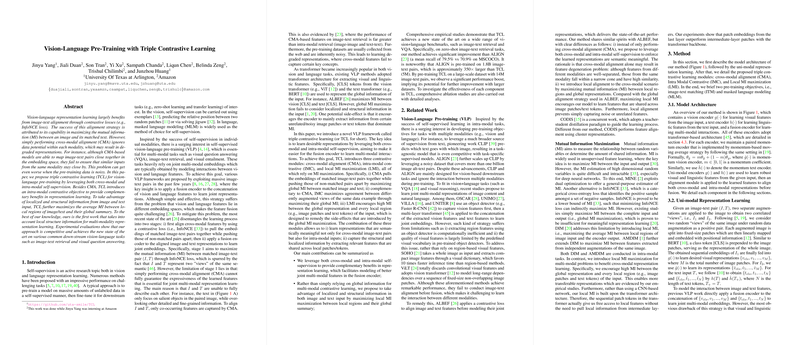Vision-Language Pre-Training with Triple Contrastive Learning
The paper "Vision-Language Pre-Training with Triple Contrastive Learning" introduces a novel framework to enhance vision-language representation learning through a technique called Triple Contrastive Learning (TCL). This method addresses the limitations of traditional cross-modal alignment (CMA) based pre-training strategies by incorporating both intra-modal contrastive objectives and local mutual information (MI) maximization.
Key Contributions
- Triple Contrastive Learning (TCL): The essence of TCL lies in its three-fold approach, integrating cross-modal alignment (CMA) with intra-modal contrastive (IMC) learning and local MI maximization (LMI).
- CMA uses contrastive losses like InfoNCE to align image-text pairs in the embedding space but often neglects potential within each modality. TCL extends beyond simply mapping image-text pairs and ensures similar inputs within each modality remain close.
- IMC enhances representation learning by maximizing agreement between augmented views of the same data, thereby complementing CMA.
- LMI captures localized and structural information by maximizing MI between local regions (e.g., image patches/text tokens) and their global representations.
- Enhanced Multi-Modal Representation Learning: TCL leverages both cross-modal and intra-modal self-supervision to improve the expressive power and alignment of learned features, resulting in enhanced joint multi-modal embeddings crucial for tasks like image-text retrieval and visual question answering (VQA).
- Empirical Superiority: The proposed method achieves new state-of-the-art results on several vision-language benchmarks. Specifically, TCL significantly outperforms previous models on zero-shot image-text retrieval on datasets such as MSCOCO and Flickr30K, demonstrating the robustness and applicability of the model across diverse tasks.
- Scaling Efficiency: Despite using a comparatively smaller pre-training dataset, TCL demonstrated superior performance over ALIGN, a model trained on substantially larger data. This emphasizes TCL's data efficiency and potential for further enhancement with larger datasets.
Theoretical and Practical Implications
- Theoretical Insights: TCL's structured approach to leveraging intra-modal supervision with local MI highlights the importance of comprehensive feature learning across and within modalities. By explicitly considering locality and structure, TCL presents a significant shift in how mutual information can be strategized in contrastive learning setups.
- Practical Applications: In practical scenarios, TCL can significantly enhance the performance of vision-LLMs used in real-world applications, from sophisticated search engines to interactive AI systems requiring an understanding of multiple modalities.
Future Prospects
The paper opens avenues for further exploration in integrating localized information with global representations. Future work could delve into the impact of different types of image and text perturbations in the perceiving ability of the model and explore larger, more diverse datasets to fully harness the potential of TCL.
In conclusion, the introduction of Triple Contrastive Learning for vision-language pre-training represents a notable advancement in multi-modal representation learning, providing a robust framework that significantly enhances the alignment and expressiveness of learned features across complex modalities. This approach not only sets a new benchmark in current tasks but also paves the way for future innovations in the field.
